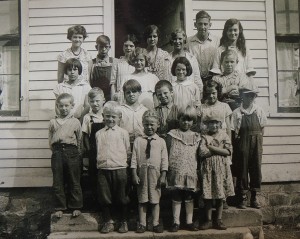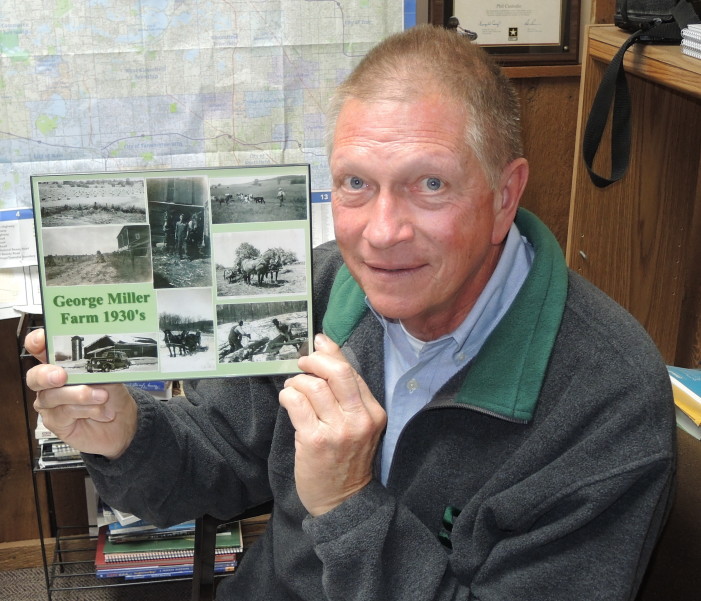George White has fond memories of helping out on the Miller family farm. Photo by Phil Custodio
Second in a series on the families who helped build Clarkston and the descendants who still live here, carrying on their legacy.
BY PHIL CUSTODIO
Clarkston News Editor
George Miller, a 19th century settler of Independence Township, has several descendents still living in the area.
George White is a sixth generation descendent of the settler, and Charlotte Maybee is a fifth generation descendent.
“His mother and my mother were Millers,” Maybee said. “George is my cousin. We had good times.”
Growing up, White would visit her and other relatives with his parents.
“Life was different back then. Nothing was open on Sunday. That was a day for church and visiting relatives. We were continuously visiting family,” he said. “That connectiveness has been lost because of the changing ways we do things.”
Their ancestor George Miller, 1801-1881, settled in the township in the early 1830s. At the time of his death in 1882, he owned 300 acres of farm land, and was known as a successful farmer and stock raiser.
“I had a sense we went back quite a ways, but it didn’t impact me until later – when I started researching it five or six years ago, it was really interesting,” White said. “For the early settlers, the area was primarily agricultural. In 1860, it was all farms. By the 1970s, there were only a couple farmers left, Bob Beardslee and my uncle (also named George Miller).”
Both White and Maybee helped out at their family farms when they were little.
“I’ve had an affinity for farms since I was 5-6 – I’d spent weekends and summers at my uncle and grandmother’s farm,” White said. “My grandmother would go into town for groceries and pick me up. I’d help on the farm, feed the calves, drive the tractor.”

His uncle farmed until the mid 1970s and passed away in 1986. The Miller family farmhouse is still on Pine Knob Road north of Bailey Lake Elementary, though the farm area is now subdivided into neighborhoods.
“One barn is still in good shape,” he said.
He remembers stories from his uncle about the hard work on a farm.
“It’s amazing to look back at the farm of the ’30s and ’40s,” he said. “No combines, they’d have threshing machines go from farm to farm – neighbors were working together.”
His uncle George had a pair of mules for farming.
“It was extremely physical and demanding,” White said. “They had no electricity on the farm until 1935. For their dairy operations, they’d cool milk with running water. I don’t know how they did it. Everything the did was without electricity. We don’t know how to function without flipping a switch. That was the way they lived.”
Maybee would help out on her family farm during hay time, when they would work to store baled hay in the barn.
“Seasonal things like that,” she said. “We had a baler, and dad bought an elevator. I would flip bales onto the elevator. We’d get through the hay season without too much difficulty.”
Threshing time was always fun, she remembers.
“We have work crew of farmer friends over, which always meant big dinners – it was so exciting,” she said. “The best part was there was room at the table for me, to sit with the men. That was living.”
Maybee Road is named after her family, but that wasn’t a big deal growing up, Charlotte said.
“We weren’t into family names and popularity and that kind of thing,” she said.
Families didn’t lobby for naming rights, she said.
“When Detroit Edison was wiring the area with electricity, they needed street names, so they named a lot of the streets after the pioneer families,” she said. “We were busy just eking out an existence.”
Charlotte is the great great granddaughter of John Maybee, who settled in Independence Township from New Jersey in the 1840s.
“I visited New Jersey 20 years ago – I was curious about where we came from,” she said. “It was the worst farming country I have ever seen.”
She remembers coming to downtown Clarkston on weekends.
“Clarkston was where we went Saturday nights for groceries and news of what was going on,” Charlotte said. “It was small. Everybody knew everybody.”
White remembers heading downtown on Fridays.
“We’d get dressed up and come into town,” he said. “They’d show movies on the wall up on the second floor. It was interesting, the way kids functioned.”
For fun, they would play card games and sing songs, he said.
“No video games. It was a different way of interacting and communicating,” he said. “When I was growing up, I remember getting together with neighbors to play cards. That’s unheard of today. Just a different way of socializing.”
Family research allows the current generation to look back and see where their family came from, to see the big picture, said White, who is putting together a compilation of genealogical materials for his children and grandchildren.
“It’s important for people to understand where we came from, all the interactions of the families,” he said. “We’re such a social melting pot.”
It’s enjoyable and important to have that understanding, he said.
“For people to see the consequences of early settlers, how they evolved over time and how families stayed here and made Independence Township their home,” he said.
The Clarkston News and Tom Stone, longtime resident and genealogist, are highlighting every month local families who have lived in the area for at least 100 years.


